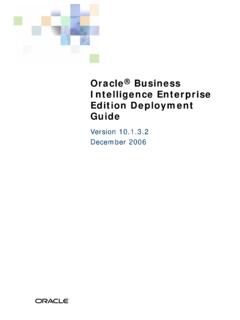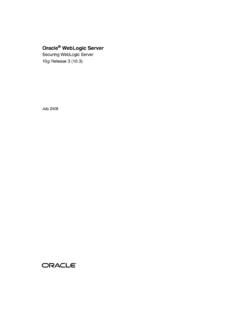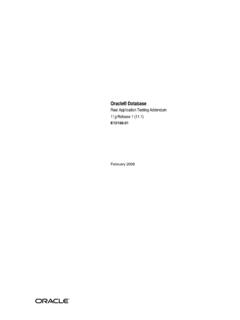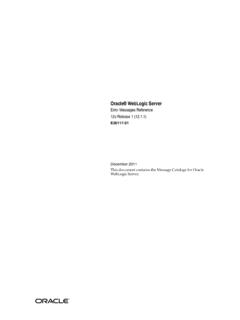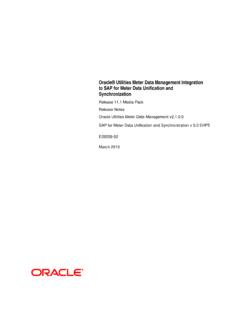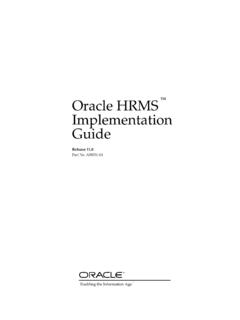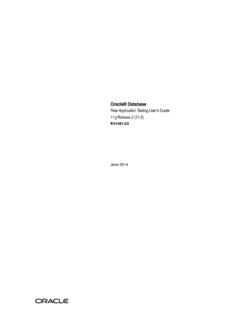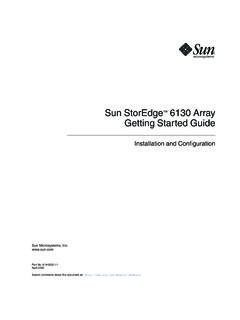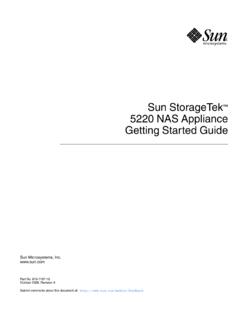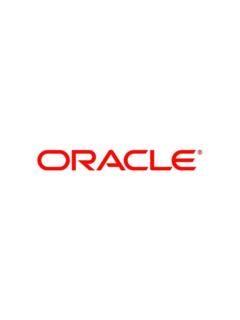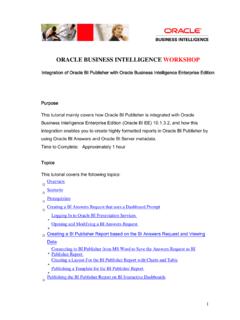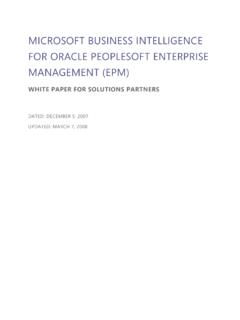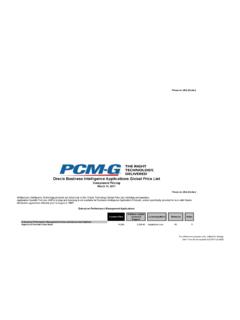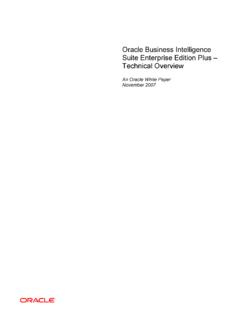Transcription of Oracle® Fusion Middleware Business Intelligence …
1 oracle Fusion MiddlewareSystem Administrator's Guide for OracleBusiness Intelligence enterprise Edition12c ( )E91534-04 September 2020 oracle Fusion Middleware System Administrator's Guide for oracle Business Intelligence enterprise Edition,12c ( )E91534-04 Copyright 2015, 2020, oracle and/or its Author: Hemala VivekContributing Authors: Christine Jacobs, Nick Fry, Stefanie : oracle Business Intelligence development, product management, and quality assurance software and related documentation are provided under a license agreement containing restrictions onuse and disclosure and are protected by intellectual property laws. Except as expressly permitted in yourlicense agreement or allowed by law, you may not use, copy, reproduce, translate, broadcast, modify, license,transmit, distribute, exhibit, perform, publish, or display any part, in any form, or by any means. Reverseengineering, disassembly, or decompilation of this software, unless required by law for interoperability, information contained herein is subject to change without notice and is not warranted to be error-free.
2 Ifyou find any errors, please report them to us in this is software or related documentation that is delivered to the Government or anyone licensing it onbehalf of the Government, then the following notice is GOVERNMENT END USERS: oracle programs (including any operating system, integrated software,any programs embedded, installed or activated on delivered hardware, and modifications of such programs)and oracle computer documentation or other oracle data delivered to or accessed by Governmentend users are "commercial computer software" or "commercial computer software documentation" pursuantto the applicable Federal Acquisition Regulation and agency-specific supplemental regulations. As such,the use, reproduction, duplication, release, display, disclosure, modification, preparation of derivative works,and/or adaptation of i) oracle programs (including any operating system, integrated software, any programsembedded, installed or activated on delivered hardware, and modifications of such programs), ii) Oraclecomputer documentation and/or iii) other oracle data, is subject to the rights and limitations specified in thelicense contained in the applicable contract.
3 The terms governing the Government s use of oracle cloudservices are defined by the applicable contract for such services. No other rights are granted to the software or hardware is developed for general use in a variety of information management is not developed or intended for use in any inherently dangerous applications, including applications thatmay create a risk of personal injury. If you use this software or hardware in dangerous applications, then youshall be responsible to take all appropriate fail-safe, backup, redundancy, and other measures to ensure itssafe use. oracle Corporation and its affiliates disclaim any liability for any damages caused by use of thissoftware or hardware in dangerous and Java are registered trademarks of oracle and/or its affiliates. Other names may be trademarks oftheir respective and Intel Inside are trademarks or registered trademarks of Intel Corporation.
4 All SPARC trademarks areused under license and are trademarks or registered trademarks of SPARC International, Inc. AMD, Epyc,and the AMD logo are trademarks or registered trademarks of Advanced Micro Devices. UNIX is a registeredtrademark of The Open software or hardware and documentation may provide access to or information about content, products,and services from third parties. oracle Corporation and its affiliates are not responsible for and expresslydisclaim all warranties of any kind with respect to third-party content, products, and services unless otherwiseset forth in an applicable agreement between you and oracle . oracle Corporation and its affiliates will notbe responsible for any loss, costs, or damages incurred due to your access to or use of third-party content,products, or services, except as set forth in an applicable agreement between you and PrefaceAudiencexxiiDocumentation AccessibilityxxiiRelated Documentation and Other ResourcesxxiiConventionsxxiii New Features for oracle Business Intelligence SystemAdministratorsNew Features and Changes for oracle BI EE 12 c ( )xxivNew Features and Changes for oracle BI EE 12 c ( )xxivNew Features and Changes for oracle BI EE 12 c ( )xxivNew Features and Changes for oracle BI EE 12c ( )xxvNew Features and Changes for oracle BI EE 12c ( )xxvPart I Administering oracle Business Intelligence1 Introduction to oracle Business Intelligence System AdministrationWhat Are the oracle Business Intelligence System Administration Tasks?
5 1-1 Getting Started with Managing oracle Business Intelligence1-2 What Is the oracle Business Intelligence System Logical Architecture?1-3 oracle Business Intelligence System Architecture1-4 oracle Business Intelligence Components1-4 About the Administration Server, Managed Servers, and System Components1-5 Key Directories in oracle Business Intelligence1-7 What System Administration Tools Manage oracle Business Intelligence ?1-7 Fusion Middleware Control1-8 oracle WebLogic Server Administration Console1-8 Process Control Commands1-9 oracle WebLogic Scripting Tool (WLST)1-9 oracle BI AdministrationTool1-9iiiCatalog Manager1-9 Job Manager1-10 Working with the Sample Application1-10 oracle BI Publisher Integration1-10 Topics of Interest in Other Guides1-10 System Requirements and Certification1-11 Part II Managing Processes and Components2 Managing oracle Business Intelligence ProcessesAbout Managing oracle Business Intelligence Processes2-1 Conditions for Starting the oracle Business Intelligence System2-1 Using Commands to Start, Stop.
6 And View Status of oracle BI EE Processes2-2 Starting oracle Business Intelligence Component Processes in a Domain2-2 Stopping oracle Business Intelligence Component Processes in a Domain2-3 Viewing the Status of oracle Business Intelligence Components in a Domain2-4 Using Fusion Middleware Control to Start and Stop BI System ComponentProcesses2-5 Using Fusion Middleware Control to Start and Stop Java Components2-6 Using oracle WebLogic Server Administration Console to Start and Stop JavaComponents2-7 Part III Scaling and Deploying for High Availability and Performance3 Scaling Your DeploymentAbout Scaling oracle Business Intelligence3-1 Setting Up Shared Files and Directories3-3 Changing the Singleton Data Directory (SDD)3-3 Setting Up the Global Cache3-4 Managing Capacity in oracle Business Intelligence (Vertically Scaling)3-4 Adding System Components3-5 Removing System Components3-7 Managing Availability in oracle Business Intelligence (Horizontally Scaling)
7 3-8 Adding New Computers3-8 Removing Existing Computers3-11 Validating That Your System Has Been Scaled Correctly3-12 Using Fusion Middleware Control to View System Component Availability3-12ivUsing the Administration Console to View Managed Server Availability3-134 Deploying oracle Business Intelligence for High AvailabilityAbout oracle Business Intelligence Components in a Clustered Environment4-1 Recommendations for Availability4-3 Using Fusion Middleware Control to Identify Single Points of Failure4-3 Achieving High Availability Using an Active-Passive Model4-3 Configuring oracle Business Intelligence Components for High Availability4-4 Optional Configuration for oracle Business Intelligence High Availability4-4 Setting Optional Cluster Controller Parameters4-4 Setting Optional Presentation Services Parameters4-5 Setting Optional oracle BI Presentation Services Plug-in Parameters4-6 Using the Cluster Manager4-6 Viewing and Managing Cluster Information4-7 Status Information4-7 Cache Information4-8 Session Information4-9 Server Information4-11 Troubleshooting a Fusion Middleware Control Clustered Environment4-11 Avoiding Errors with Network Appliance Devices When the oracle BI Server IsRunning on Linux or UNIX4-115 Managing Performance Tuning and Query CachingMonitoring Service Levels5-1 Using Fusion Middleware Control to View All oracle Business IntelligenceMetrics5-2 Using the Administration Console to View Metrics for Java Components5-2 About Query Performance Tuning5-3 Setting Performance Parameters in Fusion Middleware Control5-4 Using Fusion Middleware Control to Disallow RPD Updates5-4 Using Fusion Middleware Control to Set the User Session Log-Off Period5-5 Using Fusion Middleware Control to Set Configuration Options for Data inTables and Pivot Tables5-5 Using Fusion Middleware
8 Control to Set the Maximum Number of RowsProcessed to Render a Table View5-6 About the oracle BI Server Query Cache5-7 Query Cache Architecture5-7 Advantages of Caching5-8 Costs of Caching5-8 Disk Space5-9vAdministrative Tasks5-9 Keeping the Cache Up To Date5-9 CPU Usage and Disk I/O5-9 Cache Sharing Across Users5-10 About the Refresh Interval for XML Data Sources5-10 About the Global Cache5-10 Configuring Query Caching5-12 Using Fusion Middleware Control to Enable and Disable Query Caching5-13 Using Fusion Middleware Control to Set Query Cache Parameters5-13 Manually Editing Additional Query Cache Parameters5-13 Using Fusion Middleware Control to Set Global Cache Parameters5-14 Manually Editing Additional Global Cache Parameters5-14 Monitoring and Managing the Cache5-15 Choosing a Cache Management Strategy5-15 Disabling Caching for the System5-15 Caching and Cache Persistence Timing for Specified Physical Tables5-15 Configuring oracle BI Server Event Polling Tables5-16 Purging and Maintaining Cache Using ODBC Procedures5-16 About ODBC Procedure Syntax5-18 About Sharing the Presentation Services Query Cache5-18 About Result Records5-19 Storing and Purging Cache for SAP/BW Data Sources5-19 How Repository Changes Affect the Query Cache5-20 Strategies for Using the Cache5-21 About Cache Hits5-22 Ensuring Correct Cache Results When Using Row-Level Database Security5-25 Running a Suite of Queries to Populate the Cache5-25 Using Agents to Seed the oracle BI Server Cache5-26 Using the Cache Manager5-27 Displaying Global Cache Information in the Cache Manager5-28 Purging Cache in the Administration Tool5-29 Cache Event Processing with an Event Polling Table5-30 Setting Up Event Polling Tables on the Physical Databases5-31 Making the Event Polling Table Active5-33 Populating the oracle BI Server Event
9 Polling Table5-34 Troubleshooting Problems with Event Polling Tables5-34 Configuring the Data Source Cache5-34 Creating a Data Source Cache on the File System5-35 Creating a Data Source Cache on a Database5-36 Managing the Data Source Cache5-39 Managing the oracle BI Presentation Services Cache Settings5-40viImproving oracle BI Web Client Performance5-42 Configuring Apache HTTP Server for Static File Caching5-43 Configuring oracle HTTP Server for Static File Caching5-45 Setting the JVM Heap Size for oracle Business Intelligence5-45 Improving Performance when Downloading Large Reports5-46 Capturing Metrics Using the Dynamic Monitoring Service5-47 Using the Dynamic Monitoring Service for Metrics5-47 Using WLST Commands for Metrics5-47 Part IV Resolving Issues6 Diagnosing and Resolving Issues in oracle Business IntelligenceWhat Diagnostic Tools Are Available?6-1 Collecting Diagnostic Bundles6-2 Viewing and Configuring Diagnostic Log Files6-2 Using Fusion Middleware Control to View Log Information, Error Messages, andAlerts6-3 Configuring Log File Rotation Policy and Specifying Log Levels6-4 Using Fusion Middleware Control to Configure Log File Rotation Policy andSpecify Log Levels6-4 Manually Changing Additional Log File Settings6-5 Diagnosing Issues Using the Log Viewer6-5 Understanding Diagnostic Log Files and Log Configuration Files6-6 What Are Diagnostic Log Files and Where Are They Located?
10 6-7 What Are Diagnostic Log Configuration Files and Where Are They Located?6-8 What Are Log File Message Categories and Levels?6-10 What is Log File Rotation?6-11 What Messages Are Included in the System Log?6-12 Managing the Query Log6-12 Configuring Query Logging6-13 Setting the Query Logging Level6-13 Setting the Query Logging Level for a User6-15 Using the Log Viewer6-15 Running the Log Viewer Utility6-15 Interpreting the Log Records6-16 Logging in oracle BI Server6-17 Using the oracle BI Presentation Services Logging Facility6-17 Setting the Logging Levels for oracle BI Presentation Services6-18 Structure for the oracle BI Presentation Services Configuration File6-18 Examples of the Formats of Logged Messages6-22viiOracle BI Presentation Services Message Structure6-23 oracle BI Presentation Services Log Filters6-23 Diagnosing Issues with Agents6-24 Debugging Agents Using Fusion MiddlewareControl6-24 Manually Debugging Agents6-25 Using ODBC/JDBC Procedures to Obtain oracle BI Server Diagnostics6-26 About the oracle BI Server ODBC/JDBC Procedures6-26 Obtaining a List of Available Diagnostic
